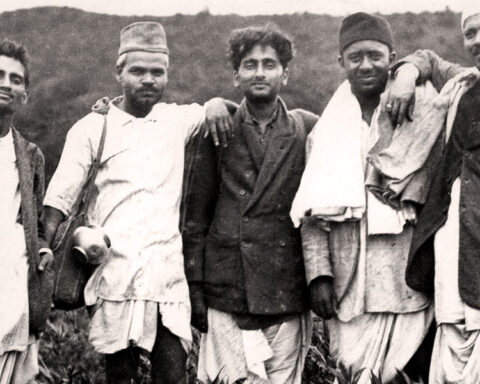There’s no denying that times are tough in the documentary marketplace. Television slots for feature docs have diminished, commissioners have their pocketbooks fastened in a death grip and—oh yeah—that pesky recession hasn’t helped either. Some feel there’s also a lingering misconception that documentaries are dullsville. With all that working against it, what’s keeping the genre from fizzling out? What’s buoying it economically? Savvy documentary distributors that have stepped up their marketing strategies deserve much of the credit, and so do moviegoers that want more than Hollywood fiction fluff. Ironically, many distributors are using a Hollywood approach to entice audiences.
Robin Smith, founder and CEO of Toronto-based film distribution and marketing company KinoSmith, is clear-cut about his technique: “Try and treat documentaries in the same light you would fiction films—give them the same weight and don’t scrimp. If you treat a documentary like a fiction film, there’s less of a stigma around it because people will think of it as being, dare I say, a ‘commercial’ film versus a niche film.”
Marketing Docs Today
With a long history of creating campaigns for both fiction and documentary films at companies including Capri Releasing and Seville Pictures, Smith has his strategy locked down. It’s the same one he recently used for the release of Last Train Home. (Produced by Montréal’s EyeSteelFilm, the company behind Up the Yangtze, both docs became box office successes when released theatrically in Canada by KinoSmith.) Smith’s goal is always to find a film’s key audience; expose them to it so they’ll help spread the word; enter domestic and international film fests to raise the film’s profile and stir up press attention; build an online presence and put out a killer trailer.
One tactic Smith definitely embraces is developing partnerships with organizations devoted to the same cause or subject as your documentary. These strategic partners often want to affiliate themselves with a good doc that speaks to their clientele, so piggybacking with them is an ideal way to maximize your dollar and exposure to your key demographic. “Hopefully the partners can move the message for you,” says Smith. That’s what happened when KinoSmith released Brett Gaylor’s RiP! A Remix Manifesto in Canada last year. The film, which steers viewers through the labyrinth of today’s copyright issues, had what Smith calls a marginally successful commercial release, but struck a chord on another level. “What’s really been working well with the movie is dealing with a lot of organizations, whether they be legal organizations dealing with copyright issues or music organizations,” he says. These allies can hold one-off screenings in their communities and potentially sell DVDs at those events.
Mongrel Media, a Toronto-based film distribution company that releases roughly 5 to 10 docs each year, also uses grassroots- level outreach when it’s the right channel through which to reach a specific target. When the company released Davis Guggenheim’s guitar doc It Might Get Loud in Canada last year, for example, it approached university music programs and asked guitar shops to put up posters. Tom Alexander, Mongrel’s director of theatrical releasing, says this type of targeted marketing works especially well with docs. “Hollywood films don’t do this sort of grassroots-style outreach because they don’t need to; they’re spending a lot of money and they want to reach as wide an audience as possible, but in my mind you have to reach the right audience.”
One place swarming with the right audience for docs is, of course, film festivals. Screening your doc at a reputable fest can boost the project’s exposure from mediocre to marvelous. “It’s a cluttered, chaotic marketplace,” says Sean Farnel, director of programming at Hot Docs Canadian International Documentary Festival. “Film festivals help focus and shape attention at the industry level, but also with our public audiences. We’re the industry’s gardeners, cultivating both talent and audiences for that talent.”
If film fests nurture audiences, the internet breeds them. The good news is you don’t have to be a YouTube guru or a Tweetaholic to amass an online following. “But at least have a really freaking solid website and start it as soon as possible so that you can start collecting data from the key individuals who will be interested in your movie,” says Smith. Something as simple as gathering postal codes through your site will allow you to set up an all-important database and keep audiences in the loop as your film’s release nears. Newsgroups and blogs are other great places to get the word out about a film online.
Once you connect with the right groups through e-outreach efforts, it’s okay to database double dip (apologies to Seinfeld). “These audiences are very present online— they communicate a lot online—so we tend to build databases that we keep using repeatedly,” says Alexander. “So if you have a documentary that incorporates some sort of social issue—let’s say the database for The Corporation, for example—you can theoretically use the same database for it as you might with Capitalism: A Love Story or any other film that takes a hard look at economic issues.”
Building a strong campaign also involves a more tangible element: a kick-ass trailer. Toronto International Film Festival documentary programmer Thom Powers points to theatrically successful docs Food, Inc. and Every Little Step: “In their marketing, they’re trying to impress upon you that they’re interesting works full of suspense and excitement.”
The D-Word
It’s too bad “suspense” and “excitement” aren’t always the words Joe Public uses when describing documentaries. Why is it that docs still get a bum rap with some audiences? Does that perception then bleed into the film and TV industry’s view of the genre? Is ‘documentary’ still a curse word?
Some broadcasters would have you think so. Take actor Michael J. Fox’s appearance on Late Show with David Letterman last year, shortly before his one-off documentary, Adventures of an Incurable Optimist, aired on ABC. It came off as though Fox had endured a terminology lesson before visiting the show. When he casually started describing the project to Letterman, “I made this documentary,” he quickly stopped himself. “Sorry—I’m not supposed to call it that—I’m supposed to call it a ‘special…’” Ouch. What gives? How did the negative connotations surrounding the genre start in the first place?
Here in Canada, it’s a matter of rewinding a few decades. Smith knows the exciting documentaries National Film Board of Canada pioneers including John Grierson originally produced, but says by the ’70s and ’80s some of the docs felt more academic than entertaining. “Not to slam them, but because documentaries were essentially the Film Board’s meat and potatoes—and it being a Crown corporation that primarily dealt with education—within Canada, there was a bit of a stigma around documentaries as being nothing more than educational pieces that the NFB put together,” he says.
Getting people excited about the genre hasn’t been a cakewalk in the U.S. either. “Undoubtedly, 10 or 15 years ago documentary could have a stigma attached to it,” says Powers, whose own production company, Sugar Pictures, is situated in New York. “When [New York-based doc-maker] Doug Block started his chat website, The D-Word, 10 years ago, it was a kind of playful reflection of the way documentary could sometimes be a stigma.” But Powers believes that’s completely changed. “I think documentary today has become almost a brand in itself that people gravitate to,” he says.
Not everyone is convinced. “The term ‘documentary’ is not a selling point in and of itself,” says Alexander. “When you’re marketing a feature film, whether it’s a documentary or not, you always have to go by the saleable points of what it’s about, and I do think the term documentary implies a certain educational aspect. The last thing you want to do is make your audience feel like they’re doing homework when they go to a movie.”
Exceptional Exceptions
One pocket within the non-fiction film world doesn’t feel anything like schoolwork and thrives in theatres, but is largely dismissed by the doc-making community: concert films. “Films like Michael Jackson’s This Is It, Hannah Montana and Miley Cyrus: Best of Both Worlds Concert and Shine a Light are big hits, but they are anomalies in the sense that they’re current musical artists,” says Alexander. “And if you look at their campaigns, they’re not marketed as documentaries; they’re marketed as event concert films. The Michael Jackson movie was originally marketed as a two-week run only…and that’s bullshit because of course then [Sony] said, ‘Oh, okay, we’ll run it for longer.’ Duh.
“People who talk about documentary film successes don’t really talk about the concert-movie experience because they see it as something different, but in my opinion it’s instructive to look at them in the same genre because you can look at what makes them sell,” Alexander continues. (And sell they do: This Is It grossed US$23.2 million at the domestic box office in its opening weekend alone last October while Hannah Montana raked in an astonishing US$31.1 million in its opening weekend in 2008.) “Basically it’s the same marketing principles that you would use with any feature film: you don’t sell it as a documentary, you sell it based on the characters, the story and the experience,” says Alexander.
That’s the same approach Mongrel used to market The Corporation. To this day, the 2003 film wins the imaginary ‘Most Commonly Referenced Project’ award during panels about commercially successful Canadian docs. “That film did a million dollars box office in Canada which, for a documentary feature, is pretty incredible,” says Alexander. “You couldn’t escape the fact that it was a documentary when you saw the trailer and everything else, but nowhere in our marketing materials did it seem like something that was homework [for audiences] because we always made it look like it was entertaining, thrilling and dramatic. I think those same principles apply whether it’s documentary, art house, independent film, foreign film or Hollywood studio film; it’s just a matter of finding which elements are going to attract your audience and then pushing those.”
The Audience Factor
What do audiences want to see these days? “Exhibition hit a banner year in 2009 in general because, with the recession, more people are going to see Hollywood escapism,” says Alexander. “I think the last thing anyone who’s lost their job wants to see is a documentary about a social issue. A good example is Capitalism: A Love Story, which most would say was disappointing box office for a Michael Moore film, despite the fact that the subject matter was extremely hot button, the film got good reviews and it was a great campaign. Similarly, [the Oscar-winning] The Cove got fantastic reviews, is a great film, very moving, but ultimately it comes down to ‘Do I want to spend my Friday night watching dolphins getting slaughtered?’”
Not everyone does. But the overabundance of moody vampire flicks and cookie-cutter romantic comedies is nauseating in its own way. “Documentaries are escapist fare—they’re an escape from vacuous corporate entertainment,” says Farnel. “We saw a dramatic increase in attendance at Hot Docs [last year] so I can only assume that audience interest will continue to grow and, in fact, has never been higher.” Powers attributes this swell of popularity to a hunger for meaningful films. “People increasingly get their information in smaller, shallower hits of news, whether it’s a Twitter feed, a YouTube clip or an article synopsis online, and I think that leaves a real appetite unsatisfied for a richer, more in-depth experience with the subject.”
Smith offers his theory: “Huge generalization here, but I think the majority of the public feel like they’ve been living in the dark for the last 20 years, whether it be about politics, environmental issues, et cetera, and there seems to be a general ‘disgruntledness’ with the human race these days. I think what has helped documentaries massively is there is—even in the time of recession—an appetite with the general public to better themselves and learn something.”
Still, he has his reservations. “As a rule, for people to go to a cinema to learn something versus being entertained is a very dangerous sword to dance on,” says Smith. “I think any good film—it doesn’t matter how educational it is or intends to be—should also be entertaining. Otherwise, what’s the point of making a movie? You might as well write a thesis paper.”
The Harsh Reality
This focus on entertainment value may have something to do with the flood of reality TV that’s inundated the airwaves over the last few years. The interest in unscripted shows has, in Smith’s view, helped docs become “semi-sexy,” but there’s a Catch 22: “I think reality TV really kicked the shit out of the traditional form of what documentaries are or should be,” he says. Unfortunately, broadcasters often clump reality shows into the same category as documentaries. “With the broadcasters that do ask for documentaries, they more often than not put brackets afterward that basically say ‘or reality TV’ and, in fact, it’s preferably reality TV over straight documentary.”
With those two types of non-fiction fare come two very different viewing experiences. Liesl Copland of William Morris Endeavor outlined the notions of “lean-forward” and “lean-back” content in her keynote speech at the Toronto International Film Festival’s inaugural Doc Conference last September. Lean-back content leads to a passive viewing experience that Copland describes as “kickin’ it at home with the lady friend on the couch, taking in a movie.” Or, in this case, a reality show. At the other end of the spectrum, “lean-forward” stories—the type documentaries often tell—motivate people to take action. Shouldn’t broadcasters more evenly distribute the airtime and funding for lean-forward and lean-back content?
Where Docs Stand Now
“Broadcast television has pretty much given up on one-off documentaries, which is a shame and maybe a crisis,” says Farnel. “The current budget allotments simply cannot sustain the level of production as we’ve known it in the past decade. And increasingly it’s an acquisitions-driven market, not a production market, which puts less money into the system. Of course, the irony is that both audience interest and filmmaker vitality have never been stronger.”
“From a filmmaker’s perspective, I think documentaries have become more viable in their heads,” adds Smith. “And, to a certain degree, it’s true. From an industry standpoint, though, docs are still not sellable commodities…the marketplace is not necessarily reacting the same way the filmmakers are. I think the marketplace still thinks of documentaries as being dry, educational pieces and not pieces of entertainment. In some cases that’s true, but to me they’re still viable.” Farnel sums up his take: “Documentaries have been popular, and given access to proper funding, will continue to be popular because audiences want to see faces, voices, stories, ideas and places that aren’t being represented elsewhere on screens.
“Watch these films and tell me docs are dry: Winnebago Man, The Yes Men Fix the World, The Red Chapel, Big River Man, About Face, 65RedRoses, Burma VJ, Inside Hana’s Suitcase, Sergio, Mugabe and the White African, Best Worst Movie, The Way We Get By, The September Issue, Tyson, A Good Man …shall I go on?”
There’s no need. The issue here isn’t whether poetic, funny and inspirational documentaries exist—they do. The real issue is getting them in front of the right audiences and building support from within the industry itself.











